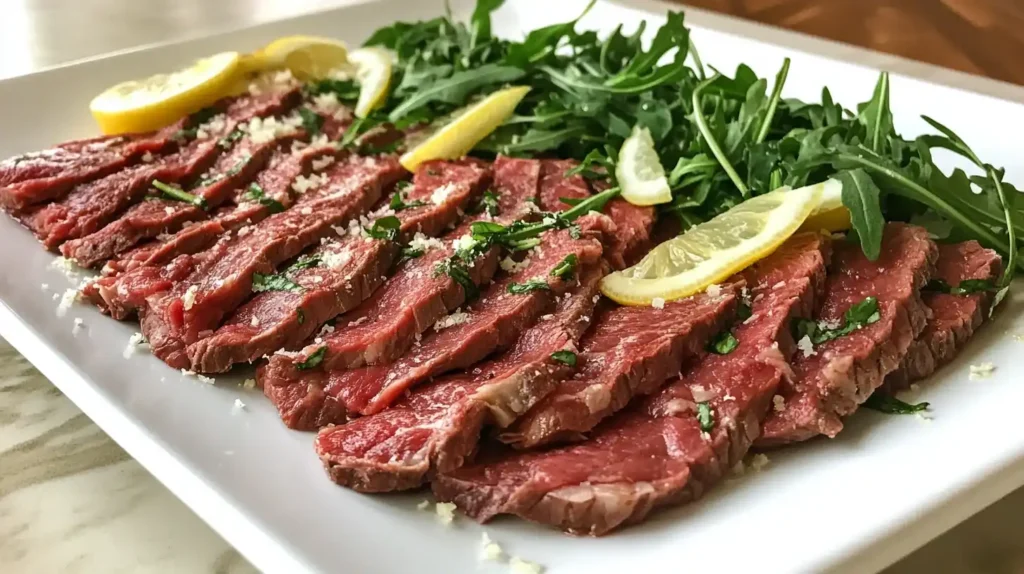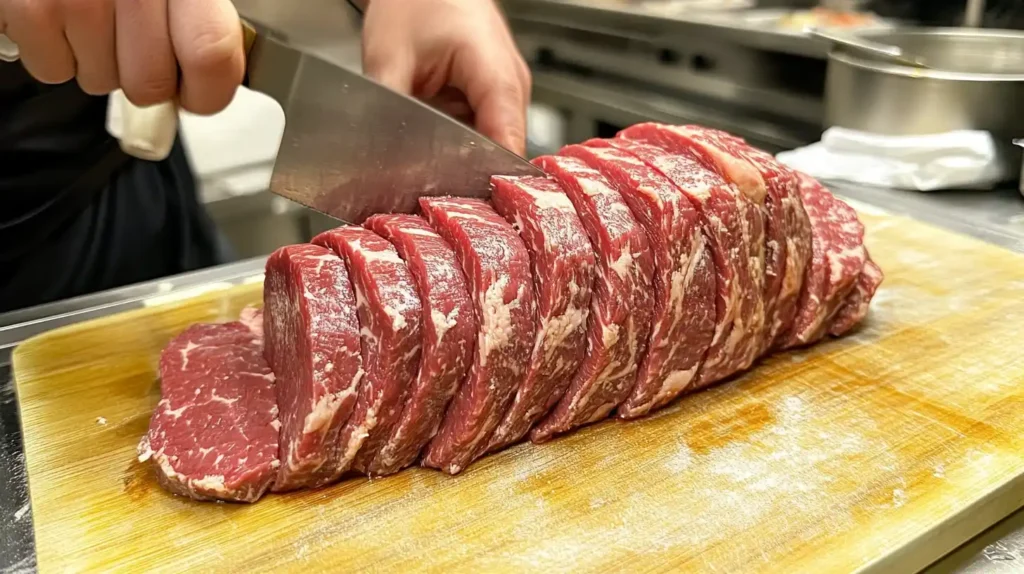A slice of beef is a common ingredient in many dishes worldwide. It can be thin or thick, raw or cooked, depending on how it’s prepared. Knowing what to call these slices and how to use them properly is essential for home cooks and food lovers alike. This guide will explain the names, uses, and preparation techniques for thin beef slices.
By learning about slicing methods and cultural dishes, you can improve your cooking skills and enjoy more flavorful meals. For those curious about techniques, Tips for Slicing Meat Thinly is a great place to start. Additionally, handling meat safely is critical, especially when preparing raw dishes.
Table of contents
Common Names for a Slice of Beef
A slice of beef can have many names depending on how it is prepared and used. These terms not only describe the cut but also hint at how it might be served. Let’s explore the most common names:
- Steak: This refers to a thick slice of beef, often grilled, pan-seared, or broiled. It is one of the most popular forms, especially for hearty meals. For example, dishes like ribeye or sirloin steak are often the centerpiece of a meal.
- Roast Beef Slices: These are thinly shaved slices typically used in sandwiches or wraps. They are perfect for quick meals or light lunches, making them a favorite in many households.
- Fillet Slices: These delicate slices are ideal for gourmet dishes or appetizers. For instance, thin fillet slices are often served in elegant preparations like carpaccio.
Each of these terms highlights the versatility of beef slices in cooking. Understanding these names allows you to choose the right cut for your recipe, ensuring better flavor and texture. Moreover, by learning these terms, you can order confidently in restaurants or at the butcher’s counter.

Cultural Names for Raw Sliced Beef
Across the world, raw beef slices go by different names, each showcasing unique cultural techniques and flavors. These dishes highlight the importance of thin slicing and fresh ingredients, creating distinct dining experiences. Here are three of the most famous examples:
- Italian Carpaccio: Italians call their thinly sliced beef dish carpaccio. Chefs serve it with olive oil, lemon juice, and arugula to keep the flavors light and fresh. This dish focuses on simplicity and high-quality meat, which makes it a favorite appetizer in Italian cuisine.
- Japanese Sashimi: In Japan, raw beef slices are known as beef sashimi. This dish pairs the meat with soy sauce and wasabi, enhancing the natural flavors without overpowering them. Japanese chefs carefully slice the beef to ensure both flavor and texture stand out.
- French Steak Tartare: The French prepare finely chopped raw beef as steak tartare. They mix it with spices and top it with a raw egg yolk to add richness. Usually, it is served with toasted bread to balance the soft texture of the beef.
Each of these dishes reflects its cultural roots and culinary traditions. By learning these names, you can better appreciate their unique preparation styles and order them with confidence when dining out. These examples also inspire you to experiment with raw beef dishes at home.
How to Slice Beef Properly
To prepare thin beef slices, you need to use the right tools and follow proper techniques. Slicing correctly not only improves the texture but also enhances the flavor of your dishes. Let’s go step by step:
- Chill the Beef Before Slicing
Place the beef in the freezer for 15–30 minutes. Slight freezing firms up the meat, making it easier to slice thinly. This step ensures your slices remain even and clean. - Use a Sharp Knife
A sharp knife helps you achieve smooth cuts without tearing the meat. Dull knives can crush the fibers, which affects both presentation and texture. - Choose the Right Cut
Selecting the right cut is critical for quality slices. Popular choices include:- Tenderloin: Known for its buttery texture, this cut is perfect for dishes like carpaccio.
- Sirloin: This cut offers a balance of flavor and tenderness, making it versatile for many recipes.
- Flank Steak: Slice against the grain to make this fibrous cut tender and enjoyable.
- Slice Against the Grain
Cutting against the grain creates shorter muscle fibers, resulting in more tender slices. This method works especially well for tougher cuts like flank steak. - Keep Slices Even
Uniform slices cook more evenly and present better on the plate. Pay attention to consistency as you slice.
By following these steps, you can create perfect beef slices for a variety of dishes, whether you’re preparing a raw appetizer or a cooked main course. Additionally, using the right tools and techniques ensures better results every time.

Uses of Sliced Beef in Cooking
Thin beef slices play a central role in many recipes, offering versatility and flavor. Whether you’re preparing appetizers, main courses, or cultural specialties, these slices add elegance and taste to your meals. Let’s explore their common uses:
- Appetizers
- Carpaccio: This dish features thinly sliced raw tenderloin, served with olive oil, lemon juice, and shaved Parmesan. It makes an excellent starter for formal dinners.
- Steak Tartare: Finely chopped raw beef is seasoned with spices and topped with a raw egg yolk. Usually, it’s served with crusty bread for added texture.
- Main Dishes
- Stir-Fried Beef: Thin slices of beef are ideal for quick stir-fries, where they cook evenly and absorb marinades or sauces well. Combine them with vegetables for a balanced meal.
- Sandwiches: Thinly shaved roast beef slices elevate sandwiches, adding tenderness and flavor. They are perfect for wraps or classic roast beef sandwiches.
- Cultural Favorites
- Bulgogi: This Korean dish uses marinated beef slices, which are quickly grilled or sautéed. The thin cuts ensure a perfect texture and flavor balance.
- Beef Sukiyaki: A Japanese hot pot dish where thin beef slices cook gently in a flavorful broth.
- Salads and Wraps
Thin beef slices can also top salads or fill wraps for a light, nutritious option. Add fresh greens, sauces, or dressings to enhance the flavor.
By using thin beef slices, you can create dishes that are both visually appealing and delicious. Their versatility allows them to fit into various cuisines and cooking methods, making them a staple in many kitchens.
Health and Safety Considerations
Handling thin beef slices safely is essential, especially when preparing raw dishes like carpaccio or steak tartare. Proper techniques help reduce the risk of foodborne illnesses and ensure the meat is safe to eat. Let’s look at some important safety tips:
- Source Beef from Trusted Suppliers
Always buy beef from reputable butchers or grocery stores. High-quality suppliers follow strict food safety standards, reducing the chance of contamination. Freshness is key, especially when the meat will be served raw. - Store Beef at Cold Temperatures
Keep beef refrigerated at or below 40°F (4°C) to prevent bacterial growth. If you’re not using the meat immediately, store it properly in airtight packaging or freezer bags. This step ensures freshness and safety. - Clean Tools and Surfaces
Always wash knives, cutting boards, and utensils thoroughly after handling raw beef. Sanitizing your tools and work area prevents cross-contamination with other foods. It also minimizes the risk of spreading bacteria like E. coli or Salmonella. - Prepare Meat Just Before Serving
Slice raw beef as close to serving time as possible. This reduces the chance of bacteria multiplying on the surface. Keeping the meat chilled until it’s ready to serve also enhances its texture and flavor. - Avoid Serving Raw Beef to High-Risk Groups
People with weaker immune systems, such as children, pregnant women, or the elderly, should avoid raw or undercooked beef. Cooking the meat thoroughly is a safer option for these groups.
By following these safety practices, you can confidently enjoy thin beef slices in a variety of dishes. Prioritizing cleanliness and proper storage not only improves safety but also enhances the overall quality of your meals.
Enhancing Flavor with Marinades
Marinating thin beef slices is one of the best ways to enhance their flavor and tenderness. A properly balanced marinade can transform a simple cut of beef into an extraordinary dish. Below, we’ll break this process into smaller steps to make it easier to follow.
Choosing the Right Ingredients
A great marinade relies on three essential elements:
- Acid: Ingredients like lemon juice, vinegar, or yogurt help tenderize the meat by breaking down its fibers. This step also adds a tangy flavor that complements the beef.
- Oil: Olive oil or sesame oil helps keep the meat moist while carrying the other flavors. Additionally, the oil prevents the slices from sticking during cooking.
- Seasonings: Fresh herbs, garlic, soy sauce, and spices add depth to the marinade, enhancing the overall taste. For example, freshly chopped basil can give the beef an aromatic twist.
By combining these components, you can create a flavorful and well-balanced marinade.
Applying the Marinade Evenly
To ensure every slice absorbs the flavor:
- Place the beef slices in a resealable plastic bag or a shallow dish.
- Pour the marinade over the meat, making sure it covers all pieces.
- Massage the bag gently or turn the slices in the dish to distribute the marinade evenly.
This step guarantees that each slice is seasoned properly, leading to a consistent taste throughout the dish.
Setting the Right Marination Time
Thin beef slices absorb marinades quickly. As a result:
- 30 to 60 minutes is usually enough to infuse flavor without compromising texture.
- Avoid marinating for too long, as the acid in the marinade can break down the meat excessively, leaving it mushy.
Timing is critical to achieving tender and flavorful beef.
Using Fresh Ingredients
Freshness makes a big difference in the final taste. Always choose fresh:
- Herbs, like parsley or thyme, to provide a vibrant aroma.
- Spices for sharper, more defined flavors.
- Oils and acidic components for a clean and balanced marinade.
Avoid using pre-made marinades, which often include preservatives that may overpower the natural flavors of the beef.
Cooking or Serving Immediately
Once marinated:
- Cook the beef slices promptly to preserve the marinade’s brightness.
- For raw dishes like carpaccio, chill the slices and serve them soon after marination to maintain freshness and safety.
Serving the meat immediately ensures that the marinade enhances its flavor without overpowering it.
By following these steps, you can create delicious and tender thin beef slices with rich, well-balanced flavors. Additionally, experimenting with different combinations of acids, oils, and seasonings lets you personalize the dish to suit your taste.

FAQs: What Is a Slice of Beef Called?
Here are some common questions about thin beef slices. Understanding these details can help you use them better in your cooking and dining experiences.
What is raw sliced beef commonly called?
Raw beef slices are known by different names depending on the dish. Popular examples include:
- Carpaccio: Thinly sliced raw beef served with simple dressings.
- Beef Sashimi: A Japanese preparation paired with soy sauce and wasabi.
- Steak Tartare: Finely chopped raw beef mixed with seasonings and garnished with a raw egg yolk.
How do you prepare raw sliced beef?
To prepare raw beef slices:
- Partially freeze the meat for firmness.
- Use a sharp knife to cut thin, even slices.
- Serve with light garnishes like olive oil or lemon juice to enhance the natural flavor.
Is raw sliced beef safe to eat?
Yes, as long as you follow proper safety measures:
- Buy beef from trusted suppliers.
- Store it in a clean, cold environment.
- Use sanitized tools and prepare it just before serving.
Avoid serving raw beef to vulnerable groups, like pregnant women, children, or the elderly.
What cuts of beef work best for slicing raw?
The most suitable cuts for raw slicing include:
- Tenderloin: Known for its buttery texture.
- Sirloin: Offers more flavor with slight firmness.
- Flank Steak: Works well when sliced against the grain.
These cuts ensure a soft texture and rich flavor, making them ideal for raw preparations.
Can you marinate raw sliced beef?
Yes, marinating raw beef slices adds flavor and tenderness. Use a combination of oil, acid (like vinegar or lemon juice), and spices. However, limit marination to 30–60 minutes to preserve the meat’s texture.
These answers address common concerns and highlight the versatility of thin beef slices. By following these tips, you can enjoy their flavor while ensuring safety and quality.
Conclusion
Conclusion
Thin beef slices are an incredibly versatile ingredient, capable of elevating both simple and gourmet dishes. From appetizers like carpaccio to hearty main courses such as stir-fries or sandwiches, these slices provide endless possibilities in the kitchen.
By understanding their uses, preparation techniques, and cultural significance, you can make the most of this ingredient. For instance, knowing how to slice beef properly not only improves its texture but also ensures even cooking. Additionally, marinating the slices adds layers of flavor, transforming a basic cut into something extraordinary.
It is equally important to handle and store the beef safely, especially when serving it raw. By following safety practices, such as sourcing high-quality meat and cleaning utensils, you can minimize risks and enjoy your dishes with confidence.
In conclusion, thin beef slices allow home cooks and professionals alike to explore a wide range of recipes and cooking styles. Whether you are recreating a classic dish or experimenting with flavors, these slices offer both versatility and satisfaction. So, the next time you’re in the kitchen, don’t hesitate to try out new techniques and recipes to make your meals unforgettable.

